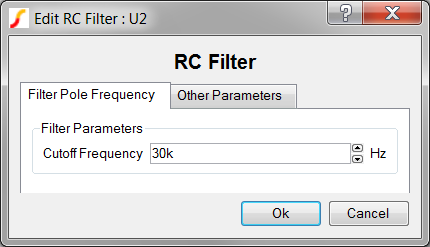Advanced SIMPLIS Training
|
To download the examples for Module 5, click Module_5_Examples.zip
In this Topic Hide
In section 5.0
and 5.1
you learned how to parameterize subcircuit symbols. At the end of 5.1
Passing Parameters Into Subcircuits Using The SIMPLIS_TEMPLATE Property,
you created a symbol with parameters that can be edited by double clicking
on the individual symbol properties. The next logical progression is to
add a parameter-editing dialog so that all parameters can be edited in
one place. SIMetrix/SIMPLIS has two different dialog functions for general
purpose parameter editing. These dialog functions can be added to any
symbol to edit the symbol properties that are passed as model parameters
to the subcircuit model.
The basic parameter-editing dialog method is based on the script function
NewValueDialog and is used to
edit most parameterized devices in SIMetrix/SIMPLIS. The NewValueDialog
parameter-editing controls can be one of five types, which are described
in the table below.
| Type | Example Control | Application |
| Real |
|
General parameters whose values can be floating point numbers |
| Integer |
|
Parameters whose values must be limited to integers |
| String |
|
Parameter values which are text |
| Boolean |
|
Logical true-or-false parameter values |
| List |
|
Parameters with values that must be limited to a list of values
Note: Although this example uses Y/N, any list of parameter values can be used. |
Creating dialog definitions using the NewValueDialog method is covered in 5.2.1 Adding Basic Parameter-Editing Dialogs. In that section of the tutorial, you will use a dialog for the parameterized RC filter circuit, which is a flat dialog without tabs and is similar to the following:

In the dialog above, the list-control type is used to edit the Filter Gain parameter. In this example, the control limits the gain to a list of values: 1, 2, 5, or 10. You can also limit the values using the real and integer control types. The fact that parameter-editing dialogs can limit the parameter values to ranges that are compatible with the model is a distinct advantage. The NewValueDialog function first divides the controls by type and then populates the dialog in the order the controls are defined.
The NewValueDialog function is described in the NewValueDialog Function topic in the SIMetrix/SIMPLIS Script Manual.
The TabValueDialog parameter-editing method allows you to organize parameter-editing controls on multiple tabs and to define the locations of each control and is, therefore, more complex than the basic NewValueDialog method. The benefits of using this method will become apparent in section 5.2.2 Adding Tabbed, Parameter-Editing Dialogs.
Starting with release 7.20, this dialog function is used to edit all SIMPLIS digital devices except the family of logic gates. This method gives you complete control over the location of the parameter-editing controls, first on the tabs you define and then inside the group boxes on those tabs. This method also provides a dialog title that includes the part being edited. The dialog shown below is configured for the parameterized RC filter circuit; this version uses the TabValueDialog function and is shown in the two images below with one for each tab to illustrate the controls arranged on multiple tabs.


In addition to the standard editing controls used in the NewValueDialog
based definitions, the TabValueDialog has three additional editing controls:
Group, Checkable Group and Label. The eight parameter-editing controls
available with this dialog function are described in the following table:
Type |
Example Control |
Application |
Real |
|
General parameters whose values can be floating point numbers |
| Integer |
|
Parameters whose the values must be limited to integers |
| String |
|
Parameter values which are text |
| Boolean |
|
Logical true-or-false parameter values |
| List |
|
Parameters with values that must be limited to a list of values
Note: Although this example uses Y/N, any list of parameter values can be used. |
| Group Box |
|
A plain group box inside a main group box that does not return
a value but allows you to group parameters inside other group
boxes.
Note: The group box with the title "A new group box" is a Group Box parameter-editing control. |
| Checkable Group |
|
A group box with a check box that returns a Boolean value and
enables or disables all
parameter-editing controls inside the group box
Note: The group with the title "Limit maximum off resistance" is a Checkable Group. |
| Label |
|
A text label which has no return value but is passed
into the dialog as a description of another parameter-editing
control
Note: The text, "Clk to Output Delay" is a Label parameter-editing control placed in the third row on the grid. |
Three factors can drive your decision on which dialog method to use:
In the next two topics, you will learn how to define parameter-editing dialog definitions.
◀ 5.1 Passing Parameters into Subcircuits Using the SIMPLIS_TEMPLATE Property |
© 2015 simplistechnologies.com | All Rights Reserved